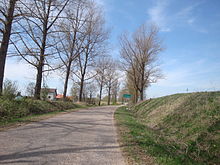Kiekskiejmy
| Kiekskiejmy | ||
|---|---|---|

|
|
|
| Basic data | ||
| State : | Poland | |
| Voivodeship : | Warmia-Masuria | |
| Powiat : | Gołdap | |
| Gmina : | Dubeninki | |
| Geographic location : | 54 ° 21 ' N , 22 ° 43' E | |
| Residents : | 57 (2009) | |
| Telephone code : | (+48) 87 | |
| License plate : | NGO | |
| Economy and Transport | ||
| Street : | Żytkiejmy / ext. 651 ↔ Skajzgiry | |
| Rail route : | no rail connection | |
| Next international airport : | Danzig | |
Kiekskiejmy ( German Kögskehmen , 1938 to 1945 Kecksheim ) is a village in the Polish Warmian-Masurian Voivodeship . It is the seat of a Schulzenamt (Polish: Sołectwo) within the rural community Dubeninki (Dubeningken , 1938 to 1945 Dubeningen) in the Gołdap district (Goldap) .
Geographical location
Kiekskiejmy on the southeast edge of the Rominter Heide (Polish: Puszcza Romincka) is east of the city of Gołdap (Goldap) in the extreme northeast of the Warmian-Masurian Voivodeship . The current state border between Poland and Russia is only three kilometers to the north. The former border between the German Empire and Poland runs five kilometers south-east.
history
Keckskeinen was founded before 1557 and before 1945 consisted of several large and small farms and farms. The name changed in the following years to Kerstekehmen (before 1589), Kägsten (before 1785) and Kiegskehmen (after 1785). In 1874 the village, then called Kögskehmen , became part of the newly established Adlersfelde district , which - after 1938 as the Unterfelde district - existed until 1945 and belonged to the Goldap district in the Gumbinnen district of the Prussian province of East Prussia .
In 1910 there were 86 registered residents in Kögskehmen. Their number rose to 90 by 1933 and remained the same until 1939.
On June 3, 1938 - officially confirmed on July 16, 1938 - Kögskehmen received the name "Kecksheim" as part of the National Socialist renaming campaign . In 1945 the village was in consequence of the war with the entire southern East Prussia Poland assigned and is called since then "Kiekskiejmy". Today it is a village with Sołectwo in Gmina Dubeninki within Powiat Gołdapski . Between 1975 and 1998 still belonging to the Suwałki Voivodeship , it is now assigned to the Warmian-Masurian Voivodeship .
Religions
Kögskehmen with its predominantly Protestant population was in the until 1945 the parish of the Church Szittkehmen in the church district Goldap within the ecclesiastical province of East Prussia the Prussian Union of churches the parish. The parish church of the few Catholic church members was that in Goldap , which belonged to the diocese of Warmia .
The church situation in Kiekskiejmy has been reversed since 1945: the now mostly Catholic population uses the once Protestant church in Żytkiejmy as their parish church, which is subordinate to the Filipów deanship in the diocese of Ełk (Lyck) of the Catholic Church in Poland . The few Protestant church members belong to the parish in Gołdap , which is a branch parish of the parish in Suwałki in the Masurian diocese of the Evangelical Lutheran Church in Poland .
Evangelical cemetery
In Kiekskiejmy there is still an evangelical cemetery from the 20th century. It is under special protection as a cultural monument.
traffic
Kiekskiejmy is not far from the DW 651 voivodship road , which connects the district towns of Gołdap / Warmian-Masurian Voivodeship and Sejny / Podlaskie Voivodeship . The village can be reached from Żytkiejmy in a south-easterly direction on the side road to Skajzgiry (Skaisgirren , 1938 to 1945 Hellerau) . A train connection has not existed since the Żytkiejmy train station on the Gumbinnen – Goldap railway line, which was disbanded in 1945 as a result of the war, was closed.
Individual evidence
- ↑ Dietrich Lange, Geographical Location Register East Prussia (2005): Kecksheim
- ^ Rolf Jehke, District Adlersfelde / Unterfelde
- ^ Uli Schubert, community directory, district Goldap
- ^ Michael Rademacher: German administrative history from the unification of the empire in 1871 to the reunification in 1990. Goldap district. (Online material for the dissertation, Osnabrück 2006).
- ↑ Walther Hubatsch , History of the Protestant Church of East Prussia , Volume 3: Documents , Göttingen 1968, p. 479

